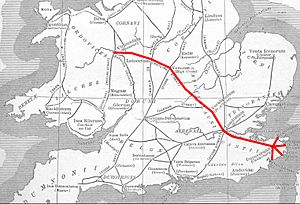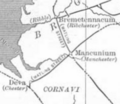Watling Street facts for kids
Watling Street is a very old road in England. It was first used by the Ancient Britons a long, long time ago. They traveled on it between places like Canterbury and St Albans.
Later, the Romans made this path into one of their most important Roman roads in Britain. The Romans were great builders! They covered parts of the road with paving stones. This is why it's called a 'street' – the word 'street' comes from an old word for paving.
The Romans paved the route from London all the way to the port of Dover. They also paved it from London to St Albans. Eventually, this amazing road stretched even further, reaching a place called Caerwent in Wales.
Watling Street Today
Today, parts of Watling Street are still used as major roads. The A2 road follows its path from Dover to London. The A5 road takes over from London to a place called Wroxeter. Wroxeter was once a Roman town called Viriconium in Shropshire. These modern roads are still very important, even with new motorways around.
Important Moments in History
Watling Street has seen many historical events. It's believed that a famous battle happened near Mancetter, a town on Watling Street. This is where the brave Queen Boudica and her army were defeated by the Romans.
Later, in the early 19th century, the part of the road between London and the coast was paved again. It became known as the Great Dover Road. Even now, you can find signs and places named Watling Street along its historic route.
Images for kids
-
Watling Street near Crick in Northamptonshire
-
The road at Richborough Castle, one of the Romans' Kentish ports and a Saxon Shore fort.
-
A paving stone on Kilburn High Road in London commemorates the route of Watling Street. (The date is incorrect.)
See also
 In Spanish: Watling Street para niños
In Spanish: Watling Street para niños








